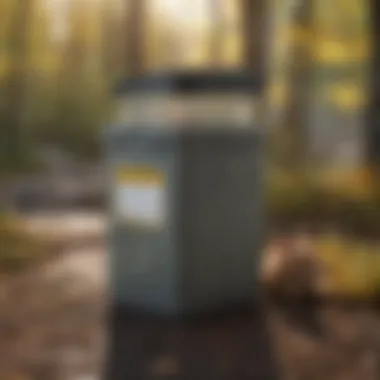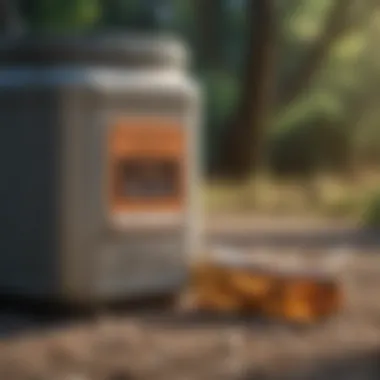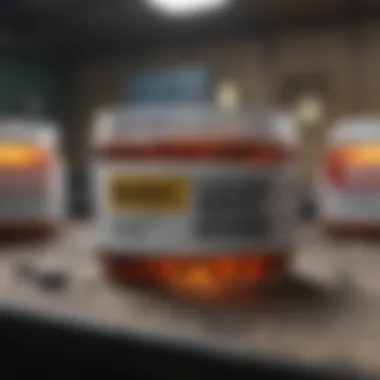Effective Methods for Disposing of Used Sharps Containers


Overview of the Topic
Disposing of used sharps containers isn’t just a matter of convenience; it’s a public health concern that gets to the heart of safety and proper waste management. While you might think that throwing out needles or other sharp instruments in the trash is harmless, the reality is far more complex. Improper disposal can lead to serious health risks, not just for those handling the waste but also for the environment at large.
Sharps containers, typically designed to hold items like needles, syringes, and blades, are essential for preventing injury and contamination. However, once they're full, they present their own set of challenges. Understanding the processes and regulations around disposing of these containers is crucial. It affects everyone from healthcare professionals to ordinary citizens who manage sharps at home, like diabetics using insulin needles.
Background Information
The significance of proper disposal practices stems from the hazards posed by needles and similar sharp items. These items can transmit infectious diseases, such as HIV, Hepatitis B, and Hepatitis C, if they puncture the skin of a person handling them. Therefore, communities need to establish solid protocols for managing these containers. The simple act of responsibly disposing of a sharps container can nip a potential public health crisis in the bud.
Learning how to navigate the disposal landscape not only aids in protecting individual health but also reinforces accountability within healthcare systems and communities. Public education campaigns play a pivotal role in informing citizens about where and how to dispose of sharps safely.
Current Status and Challenges
Current State of Sharps Disposal Practices
Despite ongoing efforts, there's a mishmash of practices and regulations about sharps disposal across different regions. Some areas have dedicated facilities for the collection and incineration of sharps, while others may lack adequate options, leaving individuals unsure of how to proceed.
In many urban settings, hospitals often have disposal guidelines in place, but individuals' adherence to these protocols varies significantly. There's an apparent need for oversight and public education to ensure that everyone understands their responsibilities regarding sharps waste.
Identification of Challenges
One of the first hurdles is the public’s awareness—or often lack thereof—about the risks attached to mishandling sharps waste. Many individuals may think that a filled sharps container can just be tossed in the trash without a second thought. Moreover, geographical disparities exacerbate the issue. In rural areas, disposal facilities may be few and far between, forcing residents to either travel long distances or avoid proper disposal entirely.
"Responsibly disposing of sharps containers is not merely an act of cleanliness—it's an essential duty to protect our communities and environment."
Sustainable Solutions
Exploring Sustainable Practices
To tackle the challenges posed by sharps waste, communities are exploring innovative solutions to streamline the disposal process. One promising approach involves the establishment of local take-back programs. In these initiatives, community health organizations partner with pharmacies or clinics to create designated drop-off points.
These take-back programs encourage responsible disposal and foster a sense of community responsibility. Individuals are incentivized to return used sharps containers safely, thereby reducing the chances of accidents during disposal.
Successful Case Studies
Some areas have successfully implemented systems that effectively handle sharps waste. For example, programs in San Francisco have established a comprehensive network for sharps disposal, including easy-to-access drop-off locations and clear communication strategies for public awareness. Meanwhile, the city of New York has invested in mobile disposal units that travel to neighborhoods in need.
These case studies illuminate the paths that other cities can take to improve their own sharps disposal measures. They serve as blueprints both for urban and rural areas, paving the way for more widespread adoption of safe disposal practices.
Impact and Importance
Analysis of the Impact
The ramifications of improper sharps disposal ripple through communities, impacting public health and the environment alike. Beyond immediate health risks, mishandling waste can lead to increased healthcare costs and a burden on municipal services. The perception of safety within a community declines when residents witness discarded needles or poorly managed waste.
Emphasizing Conservation and Responsibility
Furthermore, there’s an ecological angle to consider. Contaminated sharps can contribute to environmental degradation, entering water systems or harming wildlife. By promoting responsible disposal practices, we lay the groundwork for better community health and environmental stewardship.
Understanding Sharps Containers
When discussing the disposal of used sharps containers, it is essential to peel back the layers of what these containers truly represent. Underneath the surface, the importance of understanding sharps containers goes beyond mere waste management; it reflects a commitment to public health and safety. Sharps containers serve a fundamental purpose in healthcare settings and even at home for individuals managing certain health conditions. By comprehending these containers, individuals and communities can play a proactive role in ensuring that dispose of potentially hazardous materials is handled safely and effectively.


Definition and Purpose
Sharps containers are specially designed receptacles made to safely collect and dispose of sharp objects like needles, blades, or any items capable of puncturing skin. These containers are usually puncture-proof and sometimes even leak-proof, which is crucial in safeguarding against accidental injuries. The main purpose of these containers is to contain hazardous waste, thus minimizing the risk of injury to those handling the waste, be it a healthcare worker or a curious child.
Creating a line between safe and unsafe practices can sometimes feel like navigating a minefield, but when the definition of these containers is crystal clear, navigating that landscape becomes much more manageable. In the simplest terms, their existence is vital in promoting health safety in both clinical and non-clinical environments.
Types of Sharps Containers
It is important to recognize that not all sharps containers are created equal. Different types cater to various needs based on the environment and the type of materials being disposed of. Here are some categories worth noting:
- Single-Use Containers: Often seen in hospitals, these are disposable containers designed for one-time use. After they are full, they are sealed and disposed of in a safe manner.
- Reusable Containers: Some facilities utilize reusable sharps containers. These can be cleaned and sanitized after being emptied, though they require stringent protocols for proper maintenance.
- Home Use Containers: For individuals managing health conditions, home use containers are available. These cannot be reused and must be closed securely after use.
- Specialized Containers: Certain sharps, like those used in surgeries, may require specialized containers tailored to contain larger or more hazardous items.
Understanding the types of sharps containers not only emphasizes their relevance but also indicates to the audience which would best fit their needs. Each type comes with its own set of guidelines for usage and disposal, cementing the importance of being fully aware of which type to use in any given circumstance.
Importance of Proper Disposal
When it comes to used sharps containers, proper disposal is not just a box to check; it's an essential practice that carries significant public health and environmental implications. The manner in which these containers are handled post-use can mean the difference between safety and hazards, making it vital to understand the layers of importance surrounding this topic.
The first element to consider is health risks. Improper disposal of sharps can lead to injuries or infections not only for those who might accidentally encounter discarded containers but also for waste management personnel who handle trash. When these containers are tossed casually, they can become a source of needlestick injuries, exposing individuals to potentially serious infections, including bloodborne pathogens. A straightforward statistic illustrates this concern: according to the Centers for Disease Control and Prevention, thousands of needlestick injuries occur annually. Understanding this reality emphasizes the need for meticulous adherence to disposal guidelines.
Moreover, there's the broader picture of community health. Safe disposal contributes to a culture of responsibility. When communities prioritize responsible sharps disposal practices, they foster an environment where public health becomes a shared value. By engaging in appropriate disposal methods, individuals enhance societal awareness of health matters and promote a sense of collective accountability.
"Communities that embrace proactive health measures can create a safer atmosphere for all residents."
Next, we cannot overlook the environmental impact. Used sharps containers, generally made from plastic, do not decompose easily if discarded improperly. They may linger in landfills for decades, contributing to plastic pollution. Accidental spills from these containers can contaminate soil and water sources, posing long-term threats to ecosystems and wildlife. Considering how fragile some environmental systems are, it’s crucial to follow disposal regulations and utilize proper waste channels. By following local guidelines and programs, we can mitigate pollution and promote responsible environmental stewardship.
Local Disposal Regulations
Understanding local disposal regulations is crucial for anyone handling sharps containers. These guidelines help maintain public health and safety while ensuring that the environment is protected from potential hazards associated with improper disposal. Each locality presents its own set of rules, and adhering to these can mitigate risks to both individuals and communities. By being well-informed, one can contribute to safer disposal practices and avoid legal ramifications.
Federal Guidelines
At the federal level, the Occupational Safety and Health Administration (OSHA) and the Environmental Protection Agency (EPA) set the groundwork for sharps disposal. OSHA emphasizes that every organization must develop a handle plan for sharps to minimize exposure to waste workers. This may include safety training for individuals handling these containers. The EPA outlines that medical waste, including sharps, is subject to regulations that dictate how it must be treated, transported, and disposed of. Federal guidelines serve as a broad framework; however, specific rules can vary depending on state and local laws.
Here are some key points from federal guidelines:
- Labeling: Sharps containers need to be clearly labeled, indicating that they contain hazardous waste. This helps in ensuring that everyone handling these containers knows the risk involved.
- Storage: Temporary storage guidelines are provided to ensure that sharps do not pose a risk before they are disposed of properly.
- Disposal methods: The EPA recommends methods such as incineration and other technologies that are environmentally sound.
State-Specific Regulations
Every state imposes its own regulations that can be stricter than federal guidelines. These regulations evolve based on local health issues, population density, and the amount of medical waste generated in the area. Therefore, it is vital for residents to familiarize themselves with these laws.
Some states may require specific disposal methods, such as:
- Drop-off sites: Certain states provide designated locations for individuals to drop off their used sharps containers, often located at hospitals or health care facilities.
- Mail-back programs: This allows residents to send their filled containers to specialized facilities for safe disposal.
Knowledge of these regulations helps in maintaining compliance and understanding local options. Engaging with local authorities can also help citizens gather information about changes in laws or newly established programs that facilitate responsible sharps disposal.
"It's better to be safe than sorry. Knowing your local sharps disposal guidelines not only protects you but the whole community."
For more detailed state-specific regulations, consider visiting EPA or your local health department’s site which generally have tailored resources.
Methods of Disposal
Disposing of used sharps containers is not merely a procedural task; it’s a cornerstone of public health and environmental integrity. Understanding the methods of disposal available ensures that individuals and communities can manage sharps waste effectively, reducing health risks and environmental harm. By utilizing established disposal techniques, not only is safety prioritized, but there's also a chance for communities to engage in practices that resonate with sustainability and accountability.


Hospital and Clinic Return Programs
Many hospitals and clinics offer return programs specifically designed for sharps disposal. These initiatives allow individuals to return their full sharps containers directly to healthcare facilities, where trained professionals handle them with care. The benefits of such programs are manifold:
- Infection Control: Handling sharp objects safely minimizes the risks of accidental needle sticks, protecting both the public and healthcare workers.
- Expert Monitoring: Medical care facilities ensure that disposed containers are processed according to federal and state regulations, mitigating any chance of environmental contamination.
Participation in these programs is often straightforward. Patients can ask their healthcare providers for details, typically during appointments or by visiting the facility’s website. The ease of access to these programs speaks not only to community health but also to commitment from medical institutions to promote safe disposal practices.
Pharmaceutical Take-Back Initiatives
Pharmaceutical take-back initiatives provide an opportunity for individuals to dispose of unused or expired medicines safely, including sharps used in conjunction with these pharmaceuticals. Such programs are crucial as they help avert two main issues:
- Improper Disposal: When people flush medications or toss them in the trash, they may end up contaminating water supplies and harming wildlife.
- Accidental Exposure: Unused medical waste, including sharps, can end up in unintended hands, posing significant risks, especially to children and pets.
These initiatives are often arranged by local government or health departments. Community pharmacies may also have take-back days where individuals can bring their unwanted items. An additional benefit of these initiatives is that they often coincide with educational efforts about the proper disposal of both medications and sharps, fostering a well-rounded community approach to health and safety.
Drop-off Locations
Drop-off locations serve as a convenient option for safe disposal of sharps containers in the community. Various organizations, municipalities, and health departments often establish designated places where individuals can dispose of their used sharps safely.
- Accessibility: Many drop-off locations are strategically positioned for ease of access. This facilitates regular disposal habits among community members.
- Discreet Disposal: Knowing there are safe environments for disposal can reduce the stigma associated with sharps waste, making it easier for people to engage in responsible practices.
Individuals can often find information about local drop-off locations online or by contacting local health departments. It can also be helpful to check if these locations have specific guidelines on the type of containers accepted, ensuring that no one is turned away due to misunderstanding.
Proper disposal protects not only those who directly handle sharps but also the broader community and our environment.
In sum, understanding and utilizing these methods of disposal fortifies a collective commitment to public health and safety. Being mindful of available resources and actions can lead to a more informed and responsible approach to sharps waste management in all communities.
Home Recycling Programs
Home recycling programs serve a dual purpose in the context of used sharps containers. First, these initiatives empower individuals and families to engage in responsible disposal practices. Second, they stress the significance of waste reduction alongside proper disposal methods. In recent years, more community programs have been established to promote the safe management of sharps waste directly from households.
The importance of these programs cannot be overstated. As more medical devices become readily available for home use, individuals often find themselves disposing of used needles and other sharps. Therefore, having effective recycling programs in place ensures not only individual safety but also community health.
Home recycling programs provide several benefits. They facilitate:
- Safe access to disposal options
- Guidance on methods for different types of sharps and containers
- Community education about health risks associated with improper disposal
Participation can lead to a marked decrease in hazardous waste ending up in regular trash or landfills. This is crucial for reducing potential injury or infection that could arise when sharps are improperly discarded.
Participating in Local Programs
Joining local recycling initiatives often starts with a simple information search. People can often find resources through city websites or local health departments that list available programs. It can also be helpful to contact local pharmacies or hospitals, as these establishments sometimes offer take-back programs or can guide individuals toward the correct disposal solutions.
When looking to participate, it’s a good idea to consider the following actions:
- Research local guidelines: Understanding specific municipal regulations is key. Some areas may have designated drop-off locations where used sharps containers can be safely exchanged for new ones.
- Connect with others: Engaging with community groups or local advocacy organizations can yield insight into lesser-known disposal options.
- Stay educated: Many local programs host information sessions or workshops, offering vital knowledge about handling sharps safely.
Creating a Sustainable Experience
Sustainability within home recycling programs is more than just a buzzword; it's a way of life that can help communities reap benefits well into the future. By integrating proper sharps disposal into broader recycling efforts, households can contribute to reducing both health hazards and environmental impact.
To create a sustainable experience, consider these approaches:
- Use reusable containers: Employing containers that can be reused until full may minimize waste while ensuring safe storage until disposal.
- Track and analyze waste: Keeping an eye on the amount and type of sharps used can help households identify ways to decrease reliance on disposable sharps in the first place.
- Advocate for expansion: If a local program isn’t available, individuals can rally for better disposal solutions by contacting their local representatives or health departments.


By fostering a culture of awareness and ownership over sharps disposal, communities can build a more comprehensive recycling program that safeguards public health while contributing to environmental conservation.
"Proper disposal of sharps not only protects individuals but nurtures our environment for future generations."
In summary, home recycling programs are an indispensable part of managing sharps waste responsibly. They equip households with the tools and knowledge needed to navigate the disposal process, creating an environmentally sustainable cycle.
Creating Awareness in Communities
Creating awareness around the proper disposal of used sharps containers is essential for enhancing public safety and protecting the environment. The reality is that when folks are not informed, the risks associated with improper disposal can amplify tremendously. Education isn’t merely a bonus; it’s a necessity. By raising awareness, communities can come together to establish responsible disposal practices.
A few significant benefits come from community awareness programs:
- Reduction of Health Risks: Informing the public about the dangers of sharp waste helps minimize the risks of needle-stick injuries. People can unknowingly expose themselves or others to pathogens like HIV or Hepatitis by carelessly discarding these materials.
- Enhanced Community Cohesion: When educated about sharps disposal, individuals can rally together and support one another, fostering a sense of community responsibility. This environment encourages everyone to engage in safe disposal practices and promotes cleaner streets and parks.
- Environmental Preservation: Increased awareness can lead to a collective effort to protect our natural surroundings from pollution caused by improper disposal. Efforts in communities can bolster initiatives such as community clean-up days specifically focused on sharps waste.
In summary, creating awareness serves as the bedrock for implementing effective disposal strategies. Not only does it safeguard public health, but it also strengthens community ties while protecting the planet.
Educating the Public
Educating the public forms the backbone of an effective awareness framework. By disseminating accurate information regarding the risks of improper sharps disposal, individuals can better appreciate the importance of using designated containers and following local guidelines.
Effective education can take various forms:
- Workshops and Seminars: Organizing educational sessions at community centers offers individuals a chance to learn. Experts can give talks and demonstrate safe disposal practices, answering questions on the spot.
- Utilizing Social Media: Platforms like Facebook and Reddit provide an avenue to spread messages quickly. Creating posts that share facts about sharps disposal, highlight local resources, or even showcase personal stories can engage a wider audience.
- Informational Material: Flyers, brochures, or infographics can be distributed in high-traffic areas, such as grocery stores or clinics. Simple, eye-catching visuals can illustrate dos and don’ts of sharps disposal effectively.
Ultimately, providing clear and accessible information is key. When the public knows better, they can act better, leading to safer communities.
Engaging Community Leaders
Engagement of community leaders is a pivotal piece in the puzzle of creating awareness. Leaders have an influential voice and can mobilize resources effectively, making them ideal advocates for safe sharps disposal.
Here are some ways to engage these leaders:
- Collaborative Initiatives: Getting local leaders to participate in sharps disposal programs multiplies impact. Whether hosting a disposal drive or supporting local regulations, their participation boosts visibility and encourages public participation.
- Advocacy and Policy Making: Engaging leaders to advocate for state and local policies around sharps disposal can lead to more comprehensive regulations. When those in leadership are informed, they can push for necessary changes in waste management programs.
- Involving Local Healthcare Providers: Community health officials can be a bridge to engage leaders. They can help disseminate information and promote programs effectively. Moreover, pairing health organizations with community leaders often yields fruitful results.
Leaders can serve as role models in this initiative. Their involvement can instigate a ripple effect, encouraging others to join the cause and fostering a deeper commitment to safe disposal practices in communities.
Future of Sharps Disposal
The way we handle sharps waste is evolving, holding significant implications for public health and environmental sustainability. As the landscape of healthcare and waste management continues to shift, one can’t help but ponder how these trends affect the future of sharps disposal. New technologies and policies play a pivotal role in shaping safer practices. Not just for healthcare professionals but also for individuals managing their own medical waste at home.
Enhancements in disposal methods not only minimize risk to human health but also contribute to better stewardship of our planet. Understanding these elements gives healthcare sectors and communities the tools necessary for more effective waste management.
Innovations in Container Technology
Innovation doesn't sleep, especially when it comes to sharps container technology. Recent advancements have introduced designs that significantly enhance safety and usability. Smart containers now come equipped with features such as automated disposal alerts and lock mechanisms that prevent accidental opening. With a focus on user-friendly designs and eco-friendliness, these innovations are tailored for both individual users and healthcare facilities.
- Biodegradable Materials: Some manufacturers are using biodegradable plastics, reducing environmental harm when containers are disposed of.
- Integrated Monitoring Systems: Research is underway to implement monitoring systems within containers, allowing for real-time tracking of fill levels.
- Compact and Lightweight Designs: Accessibility is key; containers that are light yet sturdy can encourage more people to dispose of sharps safely.
"By embracing technology, we can create a future where safe disposal is as simple as it is essential."
These innovations provide dual benefits: increasing the convenience of disposal while bolstering safety measures. With technology leading the way, we can expect sharps disposal to become a more integrated component of healthcare solutions.
Trends in Waste Management Policies
When considering the future, it is crucial to note the progressive trends in waste management policies that directly impact sharps disposal. Governments are revising regulations to enhance compliance and effectiveness. Current trends include:
- Stricter Regulations: Federal and state lawmakers are prioritizing stricter regulations on medical waste, pushing for comprehensive compliance across all sectors.
- Incentive Programs: Some areas are implementing incentive structures for healthcare facilities to pursue innovative disposal solutions, thereby promoting responsible practices.
- Community-Based Initiatives: There is a growing trend towards involving local communities in waste management strategies. Collaborative efforts between local governments and citizens foster education and awareness about the importance of proper sharps disposal.
As these policies evolve, the role of advocacy groups and public awareness campaigns will be paramount. These entities help to ensure that both legislation and technology can provide a safer future for sharps disposal—one where health risks are mitigated, and environmental impacts are considered.
In summary, the future of sharps disposal rests not just in technology or regulations, but in a united effort towards awareness, education, and compliance. As we forge ahead, these factors will harmonize to create a safer and more efficient environment for all.



